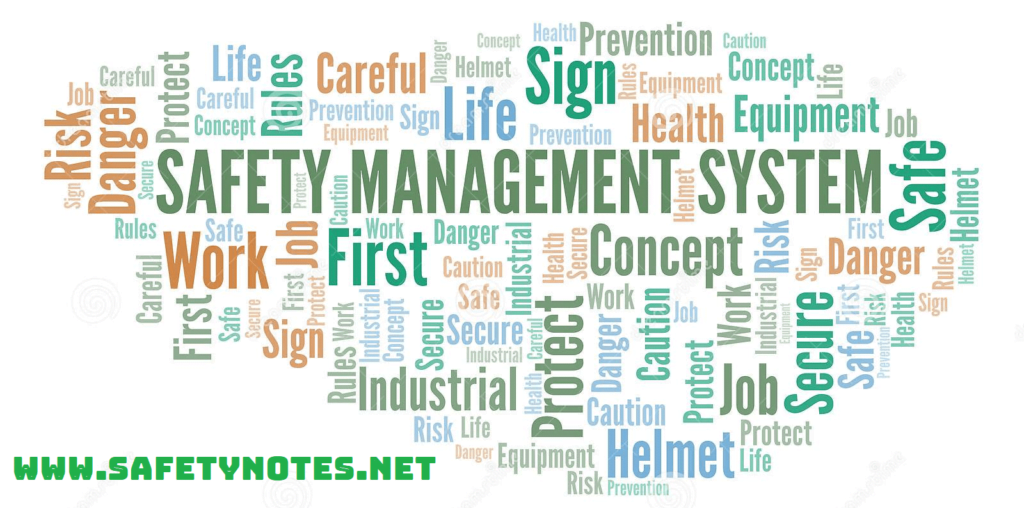Discover the key components of safety management system (sms), learn from Importance of SMS to Implementation SMS in our latest article. Learn how these systems help organizations create a culture of safety, reduce workplace accidents and injuries, and comply with regulatory requirements. From hazard identification and risk assessment to safety performance measurement and continuous improvement, this article provides a comprehensive overview of the essential components of effective safety management systems.

1. Introduction
Safety is a fundamental requirement in any workplace. Employers have a legal and moral responsibility to provide a safe and healthy working environment for their employees. One way to ensure workplace safety is through the implementation of a Safety Management System (SMS). An SMS is a comprehensive approach to managing safety that involves identifying hazards, assessing risks, and implementing controls to prevent accidents and injuries.
Implementing an SMS can help organizations to create a safety culture that promotes employee well-being and reduces workplace accidents, injuries, and illnesses. A well-established SMS can help to improve productivity, reduce costs associated with workplace accidents, and enhance an organization’s reputation.
In today’s world, safety has become a top priority for both employers and employees. With the increasing emphasis on workplace safety, having an effective SMS has become more critical than ever before. This article aims to provide a comprehensive guide to Safety Management Systems, including their importance, components, development, standards and guidelines, implementation, and monitoring. By following the guidelines outlined in this article, organizations can create a safe and healthy workplace environment that benefits both employees and employers.
2. Importance of Safety Management System
Implementing a Safety Management System (SMS) is critical to ensuring workplace safety. There are several reasons why SMS is important, including legal and regulatory requirements, reducing workplace accidents, injuries, and illnesses, and improving productivity and reducing costs associated with workplace accidents.
- Legal and Regulatory Requirements: Governments around the world have recognized the importance of workplace safety and have established legal and regulatory requirements for SMS implementation. For example, in the United States, the Occupational Safety and Health Administration (OSHA) requires employers to implement an SMS as part of their overall safety program.
- Reducing Workplace Accidents, Injuries, and Illnesses: Implementing an effective SMS can help reduce workplace accidents, injuries, and illnesses. By identifying potential hazards and implementing controls to prevent them, organizations can create a safe and healthy workplace environment for their employees.
- Improving Productivity and Reducing Costs: Workplace accidents, injuries, and illnesses can be costly for organizations. By implementing an effective SMS, organizations can reduce the costs associated with workplace accidents, such as medical expenses, lost productivity, and workers’ compensation claims. Additionally, a well-established SMS can help improve productivity by reducing the time lost due to workplace accidents and injuries.
By implementing an effective SMS, organizations can create a safety culture that promotes employee well-being and reduces workplace accidents, injuries, and illnesses. An SMS can help organizations comply with legal and regulatory requirements, reduce workplace costs, and improve productivity. In the following sections, we will provide guidance on how to develop and implement an effective SMS in the workplace.
3. Understanding Safety Management System
A Safety Management System (SMS) is a systematic approach to managing safety in the workplace. It involves identifying hazards, assessing risks, and implementing controls to prevent accidents and injuries. An SMS provides a framework for organizations to manage safety by establishing policies, procedures, and processes to ensure that safety risks are identified, assessed, and managed.
The main objective of an SMS is to create a safety culture within an organization. This culture promotes a proactive approach to safety, where everyone takes responsibility for their own safety and the safety of others. By creating a safety culture, organizations can create an environment where employees feel empowered to raise safety concerns, participate in safety programs, and report accidents and incidents.
The key components of an Safety Management System SMS include:
1. Hazard Identification and Risk Assessment
Hazard Identification and Risk Assessment (HIRA) are crucial components of any safety management system (SMS). The purpose of HIRA is to identify potential hazards within a workplace or system and assess the risks associated with those hazards.
Hazard Identification involves identifying any potential sources of harm to people, equipment, or the environment within a workplace or system. Hazards can be physical, chemical, biological, or psychological in nature. For example, a physical hazard could be a loose handrail that could cause someone to trip and fall, while a chemical hazard could be a toxic substance that could cause harm if inhaled or ingested.
Risk Assessment involves evaluating the likelihood and severity of harm associated with each identified hazard. It takes into account the potential consequences of the hazard and the likelihood of those consequences occurring. The aim is to prioritize the hazards in terms of risk so that resources can be directed towards the most significant risks first.
After identifying hazards and assessing their risks, appropriate controls must be determined to mitigate or eliminate them. This could include administrative controls, such as implementing policies and procedures, or engineering controls, such as installing barriers or ventilation systems. The goal is to reduce the likelihood and severity of harm associated with each hazard.
2. Safety Policy and Objectives
Safety Policy and Objectives outline an organization’s commitment to workplace safety and the specific goals and objectives it has for improving safety. The policy should be communicated to all employees and should be reviewed periodically to ensure its effectiveness. It sets the tone for the organization’s safety culture and provides a framework for decision-making around safety-related issues.
3. Organizational Structure and Responsibilities
Organizational Structure and Responsibilities are critical components of a Safety Management System (SMS) that provide a framework for managing safety in an organization. This involves defining the roles and responsibilities of key personnel responsible for safety management, establishing safety committees, and ensuring that all employees understand their safety-related responsibilities.
The organizational structure should clearly define the roles and responsibilities of key personnel who are responsible for safety management. This could include assigning safety responsibilities to managers and supervisors and establishing a safety committee responsible for overseeing the SMS. The structure should ensure that there is clear accountability for safety management throughout the organization.
4. Training, Communication, and Awareness
Employees need to be trained on how to work safely and be aware of potential hazards in the workplace. This involves providing safety training for new employees and refresher training for existing employees, ensuring that all employees understand their safety responsibilities, and communicating safety information effectively throughout the organization.
Effective communication is vital for maintaining a strong safety culture. The SMS should establish a clear and open communication channel for employees to report hazards and incidents without fear of retribution. This includes ensuring that employees know how to report incidents and providing a mechanism for them to do so.
5. Documentation and Record-Keeping
Documentation and Record-Keeping are important components of a Safety Management System (SMS) that ensure that safety-related activities are adequately documented and records are maintained. This is essential for monitoring the effectiveness of the SMS and for identifying areas for improvement.
Organizations must maintain detailed records of safety-related activities, including incident reports, safety audits, and training records. Incident reports should include information about the date and time of the incident, the location, the nature of the incident, and any injuries or property damage. Safety audits should document any hazards identified and the corrective actions taken to address those hazards. Training records should document the training that employees have received, including the type of training, the date of training, and the name of the trainer.
Documentation and record-keeping should be kept up-to-date and readily accessible to those who need it. This could include safety managers, supervisors, and employees involved in safety-related activities. The records should be stored in a secure location and backed up to prevent loss.
6. Safety Performance Measurement and Continuous Improvement
Safety Performance Measurement and Continuous Improvement are also essential components of an SMS. Organizations must set safety performance metrics and continuously monitor progress to identify areas for improvement. This involves analyzing safety-related data to identify trends and patterns, developing corrective actions to address deficiencies, and measuring the effectiveness of those actions.
Continuous improvement should be an ongoing process, and organizations should regularly review their SMS to ensure that it is up-to-date and effective. This could involve conducting safety audits, reviewing incident reports, and soliciting feedback from employees on the SMS’s effectiveness. The goal is to create a culture of continuous improvement that promotes safety and reduces the risk of accidents and injuries.
4. Developing Safety Management System
Developing a Safety Management System (SMS) requires a systematic approach that involves several steps. These steps include:
- Establishing a Safety Management Committee: Developing an effective SMS requires the involvement of all employees, from top management to front-line workers. Establishing a safety management committee can help ensure that everyone is involved in the development and implementation of the SMS. The committee should include representatives from all levels of the organization, including management, supervisors, and workers.
- Conducting a Hazard Assessment: The first step in implementing an SMS is to conduct a hazard assessment. This involves identifying potential hazards in the workplace, determining the likelihood and consequences of those hazards, and developing controls to eliminate or minimize those hazards. The hazard assessment should be conducted by a team of employees who are familiar with the workplace and the hazards associated with it.
- Developing an SMS Plan: Based on the hazard assessment, an SMS plan should be developed. The SMS plan should include a safety policy, roles and responsibilities, procedures and guidelines, and a training and communication plan. The SMS plan should be reviewed and updated regularly to ensure that it remains effective and relevant.
- Providing Training and Communication: Proper training and communication are essential to the success of an SMS. Employees must be trained on the procedures and guidelines developed as part of the SMS. Communication is also important to ensure that everyone is aware of the hazards and procedures in place to mitigate those hazards. Regular safety meetings, safety bulletins, and safety audits can help ensure that communication is ongoing.
- Establishing a Monitoring and Evaluation System: Once the SMS is in place, it is essential to monitor its effectiveness and make adjustments as necessary. This involves establishing a monitoring and evaluation system that includes regular audits, inspections, and reviews. The monitoring and evaluation system should be used to identify areas for improvement and to ensure that the SMS remains effective.
5. Implementing a Safety Management System
implementing a safety management system is a complex process that requires careful planning, coordination, and commitment from all levels of the organization. By following these six steps, organizations can create a culture of safety that promotes employee well-being and contributes to the success of the organization.
1. Getting Senior Leadership Support
The first step to implementing a safety management system is to obtain the support of senior leadership. Without their support, it will be difficult to secure the resources and funding needed to implement an effective safety management system. It is important to communicate the benefits of a safety management system to senior leaders and ensure that they understand the impact that it will have on the organization.
2. Establishing a Safety Management System Team
The second step is to establish a safety management system team. This team will be responsible for implementing the safety management system and ensuring that it is integrated into the daily operations of the organization. The team should be composed of individuals from various departments and levels within the organization, with expertise in safety, operations, and risk management.
3. Conducting a Gap Analysis
The third step is to conduct a gap analysis. This involves identifying the current state of the organization’s safety management practices and comparing it to the desired state. This analysis will help identify areas where improvements are needed and will serve as a guide for developing the action plan.
4. Developing an Action Plan
The fourth step is to develop an action plan. This plan should identify the specific steps that need to be taken to implement the safety management system. It should also identify the resources and timelines needed to achieve the desired results. developing an action plan is a critical step in the process of developing a safety management system. The action plan should clearly outline the specific steps needed to implement the safety management system effectively, identify the resources and timeline required, and be communicated to all relevant stakeholders. Regular review and updates of the action plan are also essential to ensure that the implementation process remains on track and effective.
5. Implementing the Safety Management System
The fifth step is to implement the safety management system. This involves integrating the new policies, procedures, and practices into the daily operations of the organization. It is important to communicate the changes to all employees and provide training to ensure that they understand the new system. implementing the safety management system is a critical step in ensuring the safety of employees and reducing safety risks and hazards in the workplace. The implementation phase requires a well-defined plan, effective communication, and comprehensive training to ensure that employees understand the new system and can use it effectively. Continuously monitoring the implementation process is essential to identify and address any issues promptly.
Implementing an effective SMS requires a significant commitment from management and employees. However, the benefits of implementing an SMS are significant, including improved workplace safety, reduced risk of workplace accidents, injuries, and illnesses, and improved regulatory compliance. By following the steps outlined above and adhering to applicable standards and guidelines, organizations can develop and implement an effective SMS that promotes employee well-being and protects the organization’s reputation.
6. SMS Standards and Guidelines
Several standards and guidelines have been developed to assist organizations in implementing an effective Safety Management System (SMS). These standards and guidelines provide a framework for developing and implementing an SMS that meets legal and regulatory requirements and industry best practices. Some of the most commonly used standards and guidelines include:
- OSHA: The Occupational Safety and Health Administration (OSHA) is a U.S. government agency that sets and enforces safety and health standards for workplaces. OSHA provides guidelines and regulations that organizations can use to develop and implement an effective SMS.
- ILO: The International Labour Organization (ILO) is a specialized agency of the United Nations that develops and promotes international labor standards. The ILO has developed a framework for occupational safety and health management systems that provides guidance for organizations on how to develop and implement an SMS.
- BSI: The British Standards Institution (BSI) has developed a series of standards for occupational health and safety management systems. The most commonly used standard is BS OHSAS 18001, which provides a framework for developing and implementing an effective SMS.
- HSE UK: The Health and Safety Executive (HSE) is a UK government agency responsible for enforcing health and safety laws. The HSE provides guidance and regulations that organizations can use to develop and implement an effective SMS.
In addition to these standards and guidelines, there are also several industry-specific guidelines that organizations can use to develop an SMS. For example, the International Air Transport Association (IATA) has developed guidelines for implementing an SMS in the aviation industry.
Implementing an SMS that meets these standards and guidelines can help organizations ensure compliance with legal and regulatory requirements and industry best practices. It can also help organizations improve workplace safety and reduce the risk of workplace accidents, injuries, and illnesses.
Implementing an Effective Safety Management Systems (SMS) with Software
Safety Management Systems (SMS) are pivotal for workplace safety, providing a structured approach to identifying and mitigating potential hazards. To enhance the effectiveness of your SMS, consider utilizing specialized software solutions like SMS360. SMS360 is a user-friendly software tool meticulously designed to support an efficient and integrated Safety Management System.These systems not only identify and mitigate risks but also foster a culture of safety within organizations. By leveraging user-friendly software tools, businesses can streamline their safety processes, making safety everyone’s responsibility and significantly reducing workplace accidents and injuries.
Conclusion:
In conclusion, safety management systems are a critical component of workplace safety. They provide a structured approach to identifying and mitigating potential hazards, and they help organizations create a culture of safety that can prevent accidents and injuries. By understanding the key components of safety management systems and implementing them effectively, organizations can create safer, more productive workplaces that benefit both employees and the organization as a whole.



Do you have YouTube channels if yes please share the link ???